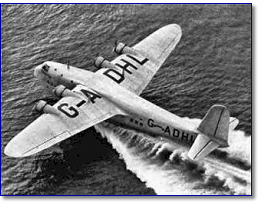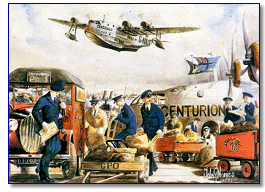
 Following Parliamentary approval of the planned Empire Air Mail Scheme in late 1934, Imperial Airways invited Short Bros of Rochester, Kent to submit proposals for a new long range flying boat. The company responded without delay with the result that the Imperial Airways decided to proceed with development 'off the drawing board' without the need for expensive and time-consuming prototypes - an indication of the confidence held by the airline in the capabilities of the Short team under Oswald Short and the Chief Designer Arthur Gouge. Following Parliamentary approval of the planned Empire Air Mail Scheme in late 1934, Imperial Airways invited Short Bros of Rochester, Kent to submit proposals for a new long range flying boat. The company responded without delay with the result that the Imperial Airways decided to proceed with development 'off the drawing board' without the need for expensive and time-consuming prototypes - an indication of the confidence held by the airline in the capabilities of the Short team under Oswald Short and the Chief Designer Arthur Gouge.The design was designated as the Short S.23 and emerged as an innovative high-wing, monoplane flying boat which represented a major advance over the earlier generation of biplane flying boat types with their multiplicity of struts and wires and limited carrying capacity and range. The twin-deck S.23 design included a hold specifically designed to carry mail, accommodation for passengers, flush riveted construction for aerodynamic efficiency and the patented Gouge flaps for excellent low-speed and take-off performance. The Imperial Airways order was placed in December 1934 for 28 of the large flying boats. At the time the flying boat was considered to be the only type of aircraft that was viable for long-range, world-wide operation. As a result of the Imperial Airways' order, “Canopus”, the first Short S.23 `C’ Class flying boat, was delivered for service at the end of October 1936. It was the largest British-built passenger-carrying monoplane of its time.  The Short ‘C’ class 'boats', as they came to be known, were initially powered by four Bristol Pegasus nine-cylinder radial engines developing 910 horsepower each. The craft had a wingspan of 114 feet, a length of 88 feet and weighed over 20 tons when fully loaded for take-off. Its maximum speed was 200 miles per hour at 5,500 feet, with an absolute ceiling of 20,000 feet. The hull was divided into two separate decks, with space for 3,000 pounds of mail and cargo on the upper deck and seats for between 17 and 24 passengers on the lower deck. The Short ‘C’ class 'boats', as they came to be known, were initially powered by four Bristol Pegasus nine-cylinder radial engines developing 910 horsepower each. The craft had a wingspan of 114 feet, a length of 88 feet and weighed over 20 tons when fully loaded for take-off. Its maximum speed was 200 miles per hour at 5,500 feet, with an absolute ceiling of 20,000 feet. The hull was divided into two separate decks, with space for 3,000 pounds of mail and cargo on the upper deck and seats for between 17 and 24 passengers on the lower deck.The porpoise-shaped Short flying boat was a handsome and airworthy craft that extended the United Kingdom Airmail Service to the farthest corners of the British Empire. On July 5 and 6, 1937 it crossed the Atlantic on a test flight that proved to be a prelude to a regular transatlantic service which was inaugurated on August 8, 1939. Unhappily, the service was interrupted after only eight flights because of the outbreak of World War II. Short ‘C’ Class flying boats were used throughout the war, and several remained in operation until 1947. By that time the 42 ‘C’ class flying boats built by Short Brothers had flown almost 38 million miles and the “Canopus”, flagship of the fleet, flew about 2,800,000 miles during its career. Ultimately, the development of larger, faster ocean- and continent-spanning aircraft rendered the Short ‘C’ Class flying boat obsolete, but during the ten years it was in use, this dependable transport established an outstanding record of service. |